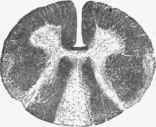2. Ascending Grey Degeneration (Ascending Sclerosis)
Description
This section is from the book "A Manual Of Pathology", by Joseph Coats, Lewis K. Sutherland. Also available from Amazon: A Manual Of Pathology.
2. Ascending Grey Degeneration (Ascending Sclerosis)
This condition occurs as a result of any cause which interrupts the ascending or sensory fibres of the cord. The degeneration affects the centripetal fibres, and these we have already seen to be of two kinds. There are the short fibres communicating between different segments of the cord, and forming the posterior root-zones, and there are the longer fibres communicating between the cord and brain, and forming the columns of Groll, the direct cerebellar, and partly the antero-lateral tracts.
Immediately above the' lesion, all of these are affected, so that the degeneration has considerable lateral extension, involving the whole of the posterior columns and the direct cerebellar tracts. But the lesion soon limits itself to the columns of Goll, the direct cerebellar, and partly the antero-lateral tracts below it, as in Fig. 311. The degeneration will diminish in both cases as we pass from the lesion, quickly at first, but afterwards more gradually.

Fig. 312. - Ascending grey degeneration. The columns of Goll and direct cerebellar tracts are visibly pale.
(see Figs. 311 and 312), and in these parts-it can be traced up to the restiform body on the one hand, and the cerebellum on the other. According to Schiefferdecker, the degeneration in these situations diminishes from below upwards, the diminution occurring at intervals as if, at definite levels, fibres passed into the grey matter of the cord.
Some cases have been recorded in which a tumour pressing on the cauda equina, or a severe traumatic lesion of the sciatic nerves, had led to ascending degeneration of the cord. In the lumbar and lower dorsal regions the whole posterior white columns were degenerated, but on passing upwards the degeneration became limited to the columns of Goll and the cerebellar fibres as above. We may infer from this that the fibres of the posterior column are, to a large extent, continuous with the posterior nerve-roots, and that they are prolongations (axons) of the cells in the ganglia of the posterior roots outside the cord. It will be evident that a lesion which interrupts the cord will lead to an ascending degeneration above its seat and a descending degeneration.

Fig. 311. - Transverse myelitis (e) with secondary ascending and descending defeneration. At d the ascending degeneration affects the posterior root-zones, the columns of Goll, and the direct cerebellar tracts, but above that it is confined to the two latter. At f to h, the columns of Tiirck and the pyramidal tracts are affected. (Brb).
Continue to:


